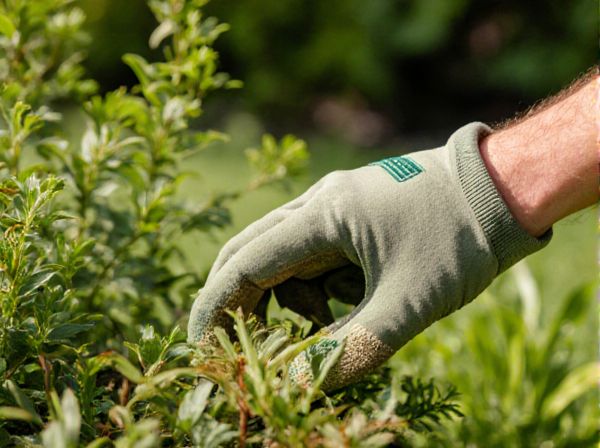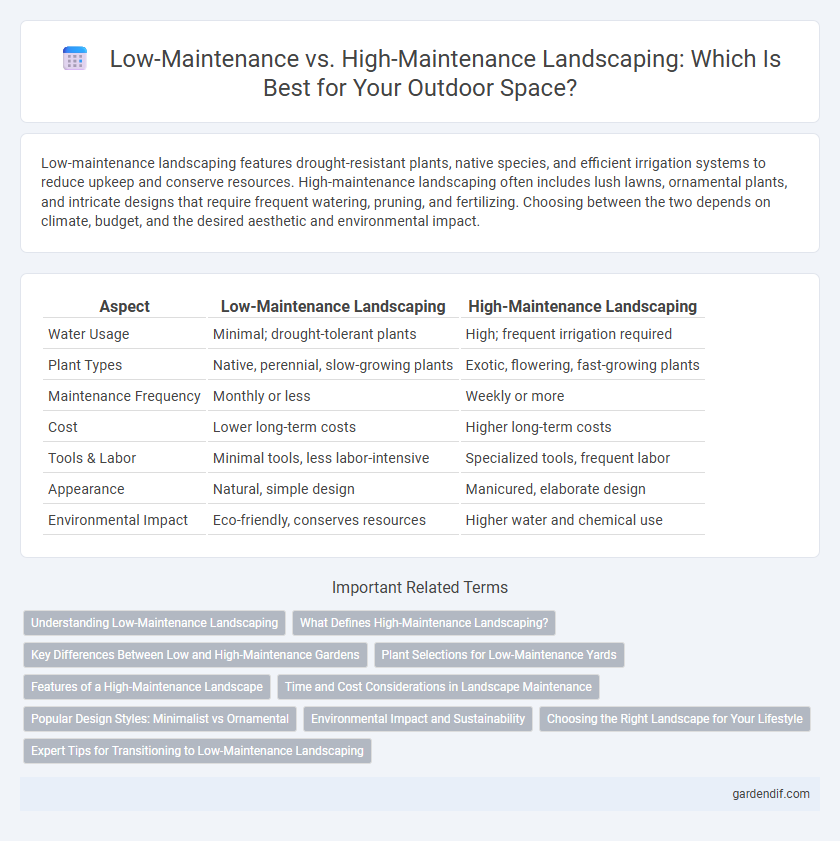
Low-Maintenance Landscaping vs High-Maintenance Landscaping Illustration
Low-maintenance landscaping features drought-resistant plants, native species, and efficient irrigation systems to reduce upkeep and conserve resources. High-maintenance landscaping often includes lush lawns, ornamental plants, and intricate designs that require frequent watering, pruning, and fertilizing. Choosing between the two depends on climate, budget, and the desired aesthetic and environmental impact.
Table of Comparison
| Aspect | Low-Maintenance Landscaping | High-Maintenance Landscaping |
|---|---|---|
| Water Usage | Minimal; drought-tolerant plants | High; frequent irrigation required |
| Plant Types | Native, perennial, slow-growing plants | Exotic, flowering, fast-growing plants |
| Maintenance Frequency | Monthly or less | Weekly or more |
| Cost | Lower long-term costs | Higher long-term costs |
| Tools & Labor | Minimal tools, less labor-intensive | Specialized tools, frequent labor |
| Appearance | Natural, simple design | Manicured, elaborate design |
| Environmental Impact | Eco-friendly, conserves resources | Higher water and chemical use |
Understanding Low-Maintenance Landscaping
Low-maintenance landscaping emphasizes drought-tolerant plants, native species, and efficient irrigation systems that reduce water usage and upkeep efforts. Utilizing mulches, ground covers, and hardscape elements like gravel or pavers minimizes weed growth and soil erosion while enhancing aesthetic appeal. This approach saves time, lowers long-term costs, and promotes sustainable garden health compared to high-maintenance landscaping requiring frequent watering, pruning, and fertilizing.
What Defines High-Maintenance Landscaping?
High-maintenance landscaping is characterized by labor-intensive upkeep, requiring frequent watering, pruning, fertilizing, and pest control to maintain aesthetic appeal. It often includes delicate plants, intricate garden designs, manicured lawns, and specialized features like elaborate water elements or ornamental trees. The continuous investment in time, resources, and expertise differentiates high-maintenance landscapes from more sustainable, low-maintenance alternatives.
Key Differences Between Low and High-Maintenance Gardens
Low-maintenance landscaping features drought-tolerant plants, minimal watering requirements, and automated irrigation systems, reducing overall time and resource investment. High-maintenance gardens often include delicate flowers, frequent pruning, and soil amendments, demanding regular attention and specialized care. The key differences lie in plant selection, upkeep frequency, and resource consumption, influencing long-term sustainability and cost.
Plant Selections for Low-Maintenance Yards
Choosing drought-tolerant plants such as succulents, ornamental grasses, and native perennials significantly reduces watering needs and soil enhancement efforts in low-maintenance landscaping. Incorporating hardy shrubs like boxwood, juniper, and lavender minimizes pruning frequency while providing year-round structure and color. Prioritizing plants adapted to local climate conditions ensures sustainability and reduces pest control requirements, making yard upkeep more efficient and eco-friendly.
Features of a High-Maintenance Landscape
High-maintenance landscaping features lush, diverse plant varieties requiring frequent watering, pruning, and fertilizing to maintain vibrant growth and aesthetic appeal. It often includes intricate garden designs, such as manicured lawns, flowering beds, and ornamental trees that demand consistent care and professional upkeep. This type of landscape typically integrates irrigation systems, pest control, and seasonal cleanups to sustain its elaborate appearance throughout the year.
Time and Cost Considerations in Landscape Maintenance
Low-maintenance landscaping significantly reduces both time and cost investments by utilizing drought-resistant plants, efficient irrigation systems, and mulch to minimize upkeep. High-maintenance landscaping demands frequent watering, pruning, fertilizing, and pest control, resulting in higher labor and resource expenses. Choosing low-maintenance options optimizes long-term budget efficiency and frees up valuable time for property owners.
Popular Design Styles: Minimalist vs Ornamental
Low-maintenance landscaping often features minimalist design styles characterized by clean lines, native plants, and gravel or mulch ground covers that reduce the need for frequent upkeep. High-maintenance landscaping embraces ornamental design styles with vibrant flower beds, intricate garden structures, and lush greenery requiring regular pruning, watering, and fertilizing. Minimalist landscapes prioritize sustainability and ease, while ornamental landscapes emphasize aesthetic complexity and seasonal visual interest.
Environmental Impact and Sustainability
Low-maintenance landscaping reduces water consumption and minimizes chemical use, promoting sustainable garden practices that protect local ecosystems. High-maintenance landscaping often requires intensive irrigation, fertilizers, and pesticides, leading to increased environmental degradation and resource depletion. Prioritizing native plants and drought-resistant species in low-maintenance designs enhances biodiversity and long-term ecological balance.
Choosing the Right Landscape for Your Lifestyle
Low-maintenance landscaping features drought-tolerant plants, native species, and efficient irrigation systems that reduce water usage and upkeep time, making it ideal for busy homeowners or those seeking sustainability. In contrast, high-maintenance landscaping often includes exotic plants, intricate garden designs, and frequent lawn care, appealing to gardening enthusiasts who enjoy hands-on involvement and aesthetic precision. Selecting the right landscape depends on balancing personal lifestyle, climate conditions, and long-term maintenance commitment to achieve functional beauty and ease of care.
Expert Tips for Transitioning to Low-Maintenance Landscaping
Transitioning to low-maintenance landscaping begins with selecting drought-tolerant native plants such as succulents, ornamental grasses, and perennials that require minimal watering and pruning. Incorporating mulch and efficient irrigation systems like drip irrigation reduces water usage and weed growth, while hardscaping elements such as gravel paths and stone patios decrease the need for ongoing upkeep. Experts recommend gradually replacing high-maintenance vegetation and investing in soil improvement techniques to ensure plant health and ease future maintenance tasks.
Low-Maintenance Landscaping vs High-Maintenance Landscaping Infographic

 gardendif.com
gardendif.com